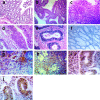Human protozoa infection and dysplasia in ulcerative colitis: a neglected aspect in a prominent disease
- PMID: 37710023
- PMCID: PMC10567919
- DOI: 10.1007/s00436-023-07972-7
Human protozoa infection and dysplasia in ulcerative colitis: a neglected aspect in a prominent disease
Abstract
The chance of getting colorectal cancer (CRC) is higher in people with chronic ulcerative colitis (UC). The impact of parasitic infections on UC is underappreciated. The purpose of this study was to look into the effect of intestinal protozoal infections on the dysplastic changes generated by UC. The research included 152 adult patients with histologically confirmed UC and 152 healthy controls. Fecal samples were examined for the presence of parasites and fecal calprotectin (FC). The enzyme-linked immunosorbent assay measured serum anti-p53 antibodies (p53Abs) and metallothioneins (MTs). The advanced oxidation protein products (AOPPs) and reduced glutathione (GSH) levels were measured by a spectrophotometric method in all subjects. Serum C-reactive protein (CRP) and IL-6 were also measured. In addition, histopathological and immunohistochemical investigations of intestinal tissue were done. Our results exhibited significant increases in FC and CRP, IL-6, AOPPs, MTs, and p53Abs in ulcerative colitis patients with parasitic infections compared to those without parasites. In contrast, GSH levels showed a significant decrease in the same group compared with other groups. Histopathological and immunohistochemical assessments of intestinal tissue signified severe inflammation and strong expression of PD-L1 in patients with parasitic infections compared to others without parasitic infections. Our research indicated a greater frequency of intestinal protozoa in UC patients with elevated inflammatory and dysplastic biomarker levels. This suggests that these parasites may be involved in the etiology of chronic UC and the associated carcinogenetic process. This is the first report of a link between parasitic infections and dysplastic alterations in UC patients.
Keywords: AOPPs; Dysplasia; FC; MTs; PD-L1; Protozoal infections; Ulcerative colitis; p53Abs.
© 2023. The Author(s).
Conflict of interest statement
The authors declare no competing interests.
Figures


Similar articles
-
p53 antibodies, metallothioneins, and oxidative stress markers in chronic ulcerative colitis with dysplasia.World J Gastroenterol. 2011 May 21;17(19):2417-23. doi: 10.3748/wjg.v17.i19.2417. World J Gastroenterol. 2011. PMID: 21633642 Free PMC article.
-
Clinical value of fecal calprotectin in determining disease activity of ulcerative colitis.World J Gastroenterol. 2008 Jan 7;14(1):53-7. doi: 10.3748/wjg.14.53. World J Gastroenterol. 2008. PMID: 18176961 Free PMC article.
-
Fecal calprotectin predicts complete mucosal healing and better correlates with the ulcerative colitis endoscopic index of severity than with the Mayo endoscopic subscore in patients with ulcerative colitis.BMC Gastroenterol. 2017 Oct 23;17(1):110. doi: 10.1186/s12876-017-0669-7. BMC Gastroenterol. 2017. PMID: 29061121 Free PMC article.
-
Monitoring of intestinal inflammation and prediction of recurrence in ulcerative colitis.Scand J Gastroenterol. 2022 May;57(5):513-524. doi: 10.1080/00365521.2021.2022193. Epub 2022 Jan 7. Scand J Gastroenterol. 2022. PMID: 34994661 Review.
-
Ulcerative colitis-associated colorectal cancer.World J Gastroenterol. 2014 Nov 28;20(44):16389-97. doi: 10.3748/wjg.v20.i44.16389. World J Gastroenterol. 2014. PMID: 25469007 Free PMC article. Review.
Cited by
-
Effects of acupuncture and moxibustion on ulcerative colitis: An overview of systematic reviews.Heliyon. 2024 Mar 8;10(6):e27524. doi: 10.1016/j.heliyon.2024.e27524. eCollection 2024 Mar 30. Heliyon. 2024. PMID: 38510004 Free PMC article.
References
-
- Alagozlu H, Gorgulb A, Bilgihan A, Tuncerb C, Unal S. Increased plasma levels of advanced oxidation protein products (AOPP) as a marker for oxidative stress in patients with active ulcerative colitis. Clin Res Hepatol Gastroenterol. 2013;37(1):80–85. doi: 10.1016/j.clinre.2012.03.034. - DOI - PubMed
-
- Aron EB, Rizvi NA, Hui R, Leighl N, Balmanoukian AS, Eder JP, Patnaik A, Aggarwal C, Gubens M, Horn L, Carcereny E, Ahn MJ, Felip E, Lee JS, Hellmann MD, Hamid O, Goldman JW, Soria JC, Dolled-Filhart M, Rutledge RZ, Zhang J, Lunceford JK, Rangwala R, Lubiniecki GM, Roach C, Emancipator K, Gandhi L. Pembrolizumab for the treatment of non-small-cell lung cancer. N Engl J Med. 2015;372:2018–2028. doi: 10.1056/NEJMoa1501824. - DOI - PubMed
MeSH terms
Substances
LinkOut - more resources
Full Text Sources
Medical
Research Materials
Miscellaneous

